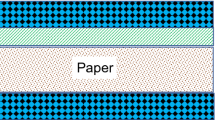Abstract
Films of whey protein and chitosan acetic acid salt have lower oxygen permeability than, for example, ethylene-co-vinylalcohol under dry conditions, but water and water vapor seriously impair the gas barrier properties. To reduce the oxygen permeability at 90% relative humidity and the water-vapor transmission rate at 100% relative humidity, the films were coated with an alkyd, a beeswax compound, or a nitrocellulose lacquer. Permeability and transmission rate measurements were performed in accordance with standard methods and showed that the beeswax compound and the nitrocellulose were appropriate as water-vapor barriers. Overall migration to water was measured after 10 days exposure time, with the coated surface exposed to the water, showing that the alkyd-coated and the nitrocellulose-coated films were both below the safety limit for food contact. Water absorbency tests, performed by the Cobb method, showed that the films coated with the beeswax compound or with nitrocellulose lacquer exhibit lower absorbency than the alkyd-coated films.
Similar content being viewed by others
REFERENCES
F. S. Kittur, K. R. Kumar, and R. N. E. Tharanathan (1998) Lebensm. Forsch. 44, 206.
Y. Makino and T. Hirata (1997) Postharvest Biol. Technol. 10, 247.
T. H. McHugh, J.-F. Aujard, and J. M. Krochta (1994) J. Food Sci. 59, 416.
M. Anker, M. Stading, and A.-M. Hermansson (1998) J. Agr. Food Chem. 46, 1820.
T. H. McHugh and J. M. Krochta (1994) J. Am. Oil Chem. Soc. 71, 307.
J. M. Krochta and C. D. Mulder-Johnston (1997) Food Technol. 61.
R. Mahmoud and P. A. Savello (1992) J. Dairy Sci. 75, 942.
P. Fairley, J. M. Krochta, and J. B. German (1997), Food Hydrocolloid. 11, 245.
T. H. McHugh and J. M. Krochta (1994) J. Agr. Food Chem. 42, 841.
R. E. Coles (1996) Flexible Retail Packs: A Literature Review, PIRA International, London, p. 90.
E. Pennisi (1992) Sci. News, 141.
Plastic Design Library (1995) Permeability and Other Film Properties of Plastics and Elastomers, PDL Handbook Series, William Andrew Inc., New York, pp. 225–258.
M. Gallstedt, J. Tornqvist, and M. S. Hedenqvist (2001) J. Polymer. Sci. Pol. Phys. 39, 985–992.
Statens Livsmedelsverks Författningssamling; Announcement from the Swedish government; SLV SS 1997:9; Sweden; Chapter 2, §4.
Author information
Authors and Affiliations
Corresponding author
Rights and permissions
About this article
Cite this article
Gällstedt, M., Hedenqvist, M.S. Oxygen and Water Barrier Properties of Coated Whey Protein and Chitosan Films. Journal of Polymers and the Environment 10, 1–4 (2002). https://doi.org/10.1023/A:1021068304169
Issue Date:
DOI: https://doi.org/10.1023/A:1021068304169




